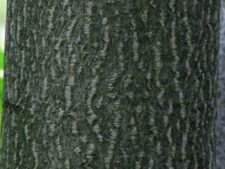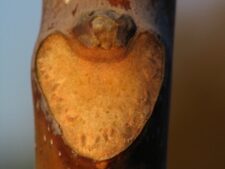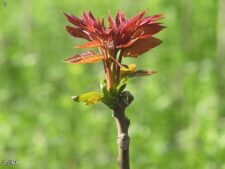
This medium-sized, invasive tree spreads rapidly, by root suckers and profuse seeding. Its straight trunk has shallow ridges (C). The large leaves have up to 41 lance-shaped leaflets opposite on the stem (A,I). Cut trees produce numerous root suckers with prominent leaf scars (D). They grow rapidly. Male and female flowers are found on separate trees. The small, greenish male flowers grow in upright clusters (G). The winged fruit (samaras) form massive clusters, first green or pinkish, later light brown (A,B,H,I).
Grows in a variety of disturbed areas, including floodplains, ravines, along roadsides, prairies, and woodlands. Flowers in May/June. Common in the Fontenelle Forest floodplain, less common in woodlands at Fontenelle Forest and Neale Woods.
This species is considered a threat to our native species; it is controlled by basal bark application of herbicide, killing the tree while standing. Cutting this species prior to herbicide treatment triggers an aggressive root suckering response, causing many new shoots to emerge from the root system. As such, cutting live trees is not recommended, even in combination with herbicide.
The content of NatureSearch is provided by dedicated volunteer Naturalists of Fontenelle Forest who strive to provide the most accurate information available. Contributors of the images retain their copyrights. The point of contact for this page is: Roland Barth.








